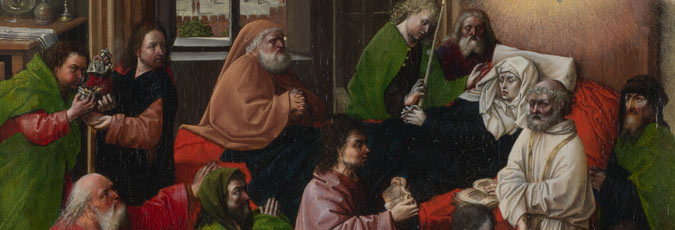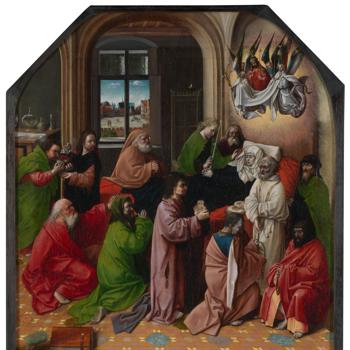After Hugo van der Goes, active 1467; died 1482
'The Death of the Virgin', probably after 1500
Oil on oak, 38.7 x 35.6 cm
NG658
This small but powerful depiction of the death of the Virgin is one of a handful of works related to Hugo van der Goes’s monumental late painting of the same subject in Bruges. The unknown painter seems to have based his composition on a related work by Hugo, now lost. X-radiographs reveal that the artist made many changes in the course of painting, which help to clarify the relationship of the National Gallery’s picture to the other paintings in the group.
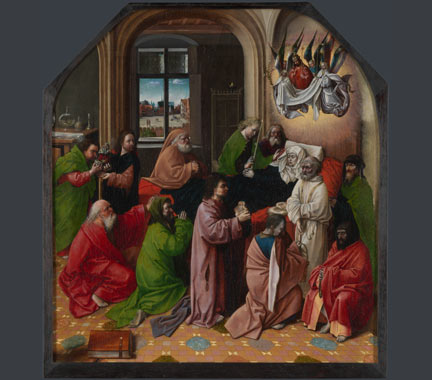
Changes in attribution
Over the past century and a half, numerous artists have been proposed as the author of this intimate depiction of the Virgin’s death. The painting entered the National Gallery in 1860 as a work by the German artist Martin Schongauer and retained this attribution until 1888, although Gallery director Sir Charles Lock Eastlake had privately recorded his doubts about it in 1863.
Subsequent attributions to an unidentified artist of the German School, ‘School of Robert Campin’, Hugo van der Goes, ‘follower of Hugo van der Goes’, and finally ‘after Hugo van der Goes’ reflect the lengthy and often confusing process of identifying the precise source of this image.
An intricate relationship
Although there are many differences between the two compositions, the National Gallery’s picture is related to Hugo van der Goes’s ‘The Death of the Virgin’ in Bruges, widely regarded as a masterpiece of the artist’s last years.
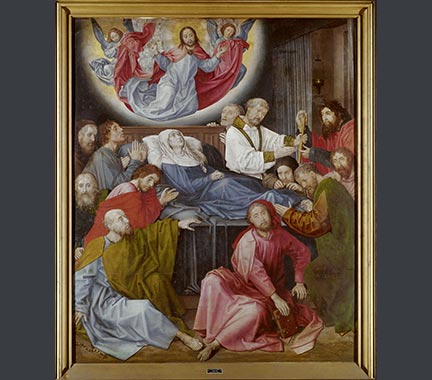
© Photo Scala, Florence
It is even more closely linked to two other small panels also depicting the death of the Virgin, in Berlin and Prague respectively. The London, Berlin and Prague paintings are all thought to reflect a now lost composition by Hugo which probably (although not certainly) preceded the painting in Bruges. They may therefore represent a crucial step in the process of developing that dense and emotionally charged composition.
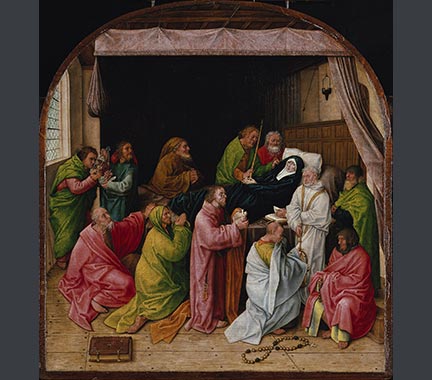
© Photo Scala, Florence / BPK, Bildagentur für Kunst, Kultur und Geschichte, Berlin
While the Berlin and Prague paintings are quite similar, the painter of the London version has taken considerable liberties with the composition. The tester (canopy) and curtains framing the scene of the dying Virgin have been removed. In their place are stone arches in the background and a cupboard at left. The window at the left side has been moved to the back of the composition and now frames a courtyard view. Over the Virgin’s head is a vision of Christ, surrounded by four angels, in a glory of light.
Working process
X-radiographs made of the London Death of the Virgin in the early 1950s, and again in 1982, revealed the extensive modifications made by the artist in the course of painting. Originally the Virgin’s bed had a tester and curtains, there was no vision of Christ and the angels, the floor was composed of wooden planks, and the window was located to the left side, in perspective, rather than at the back of the composition.
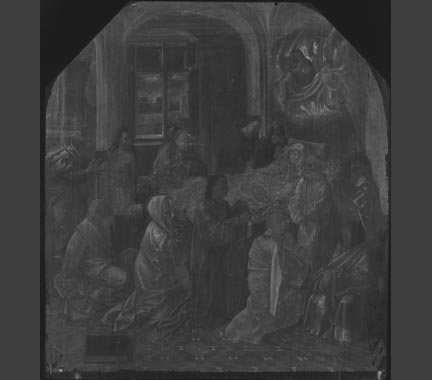
At this preliminary stage the painting more closely resembled the versions in Berlin and Prague. Cross-sections of paint samples taken from the upper portion of the painting revealed that (as in the Berlin version) the bed curtains were a purplish-red colour, painted with a mixture of azurite, red lake and some lead white.
Several of the ‘new’ features introduced by the artist of the National Gallery’s painting – the apparition of Christ, the perspectival illusion of the tiled floor and the window that now expands the space by including a view to the outside – seem to have been borrowed from the art of Robert Campin.
It is not known why the unknown painter, working about 1500 or later, chose to revise Hugo’s design by replacing much of the background with motifs inspired by an artist of the previous generation. The modifications lessen the intensely claustrophobic effect that Hugo achieved by placing a dense knot of figures in a confined space, and this may have been the copyist’s desired result.
Marjorie E. Wieseman is Curator of Dutch paintings at National Gallery. This material was published on 30 June 2010 to coincide with the exhibition Close Examination: Fakes, Mistakes and Discoveries
Further reading
L. Campbell, ‘National Gallery Catalogues. The Fifteenth Century Netherlandish Schools’, London 1998, pp. 248–53
J. Dunkerton, ‘“The Death of the Virgin”: A Technical Approach to an Art-Historical Problem’, ‘The National Gallery Technical Bulletin’ 7, 1983, pp. 21–9
B. Ridderbos, ‘Hugo van der Goes’s “Death of the Virgin” and the Modern Devotion: an analysis of a creative process’, ‘Oud Holland’ 120, 2007, pp.1–30

